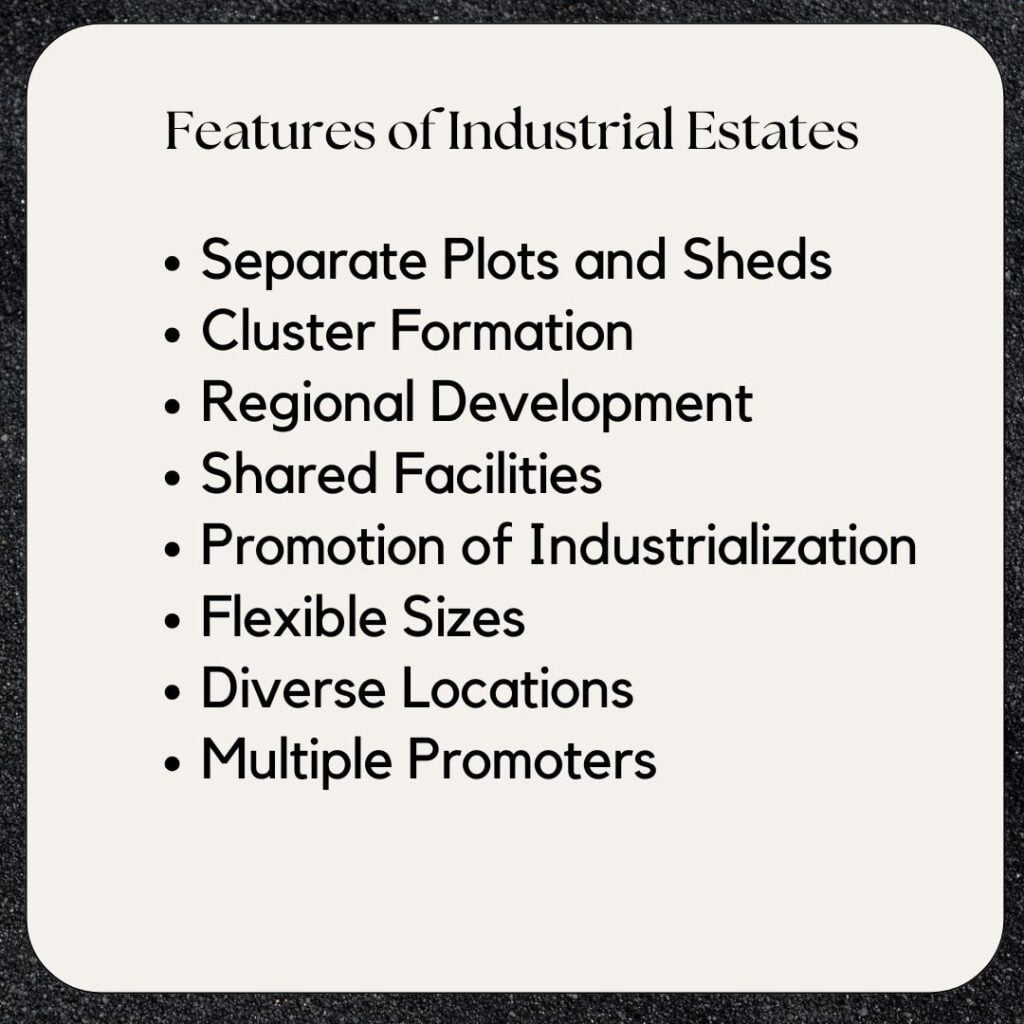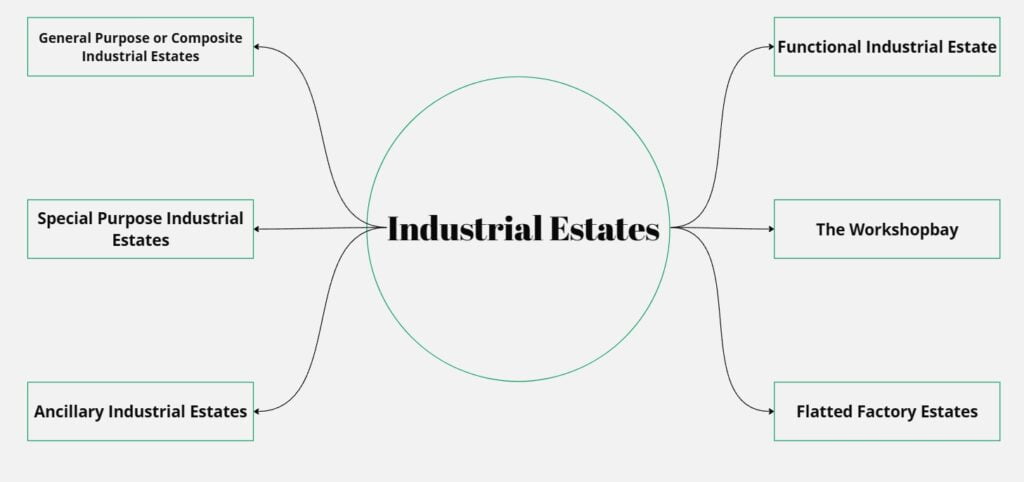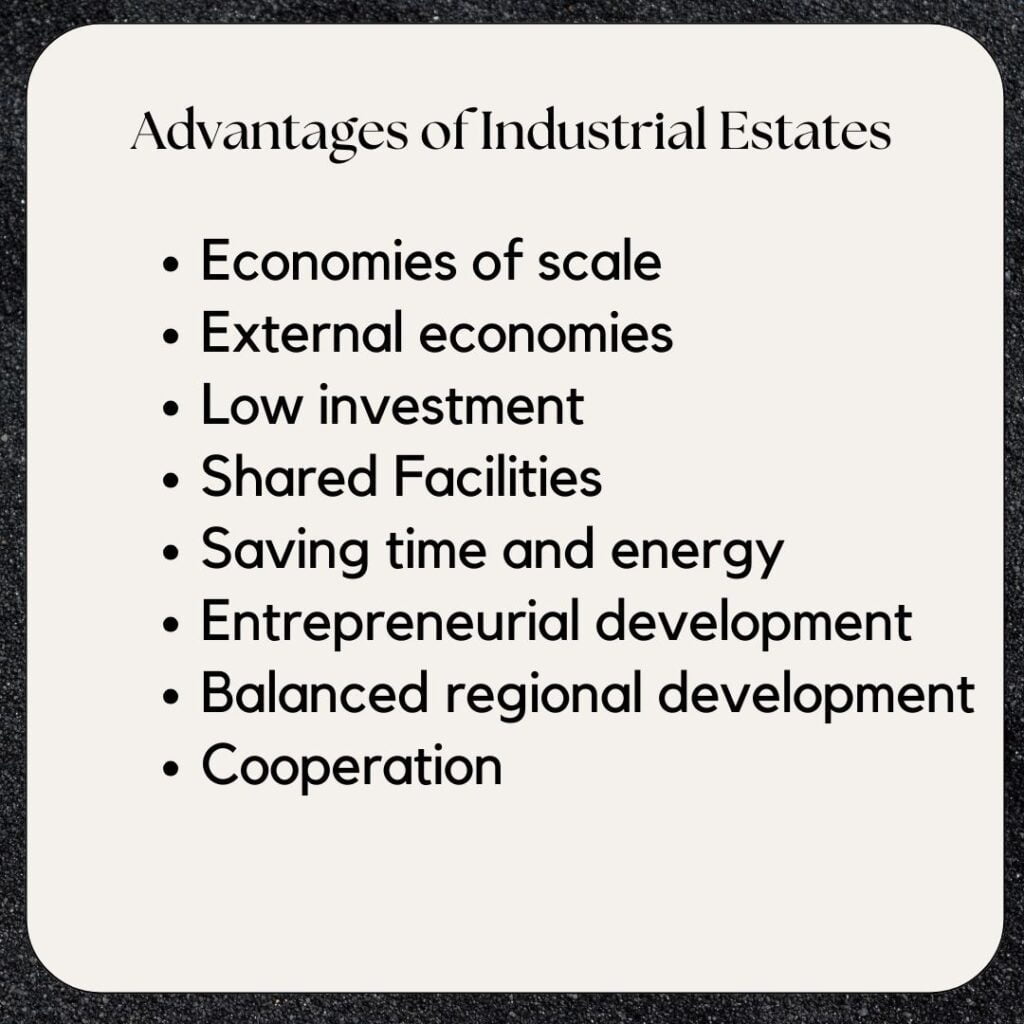Introduction
Micro, Small, and medium enterprises (MSMEs) play an important role in the growth and support of an economy. Unfortunately, their expansion is difficult due to the absence of basic infrastructure such as land, electricity, and transportation. Industrial estates help find a solution to this issue.

Industrial Estates
A major challenge in the development of MSME units is their inability to arrange land, power, transport, etc. The absence of such facilities affects the location and development of MSMEs. This difficulty discourages many of the entrepreneurs from taking up enterprises of their own. This is because it costs a lot to buy land and construct buildings. Even if an entrepreneur is prepared to make this investment, a convenient location from the point of view of production and marketing may not be available.
Further, facilities like power, water, and transport are essential but these also may pose a problem. Factories have also to conform to relevant laws and rules concerning accommodation, lighting, ventilation, washing and bathing facilities, and pollution control facilities. To encourage entrepreneurs to set up small industries and to expand existing units, a program for the establishment of industrial estates was started in the year 1955.
Industrial estates are known by various names such as industrial parks, industrial zones, industrial regions, industrial cities, industrial areas, and industrial townships.
Meaning and Definition of Industrial Estates
Industrial estate is generally concerned with industrial locality where different types of industrial units under different ownership are engaged in the production of goods and services.
The United Nations in 1963 described an industrial estate as a place where industrial businesses are grouped, with ready-made factory buildings and various services available to the occupants.
The United Nations
Dr. PC. Alexander, on the other hand, defines an industrial estate as a collection of factories built on a large scale in appropriate locations, equipped with essential facilities like water, transportation, electricity, and more, along with technical guidance and common services.
Dr. PC. Alexander
According to Bredo, an industrial estate is a piece of land that is divided and developed based on a detailed plan for the benefit of a group of industrial businesses.
Bredo
Thus, an industrial estate is a place where the government provides the required facilities and factory accommodations to the entrepreneurs to establish their industries there.
The first industrial estate was first established at Rajkot in Gujarat in 1955. In 2024, India has a whopping number of 3,800 industrial parks, estates, and Special Economic Zones (SEZs), which cover around 4.68 lakh hectares of land.
These clusters of industries play a vital role in India’s economic growth and progress. Moreover, an impressive 75% of India’s industrial clusters are concentrated in only five states.
Features of Industrial Estates

- Separate Plots and Sheds: Industrial estates allocate the entire land area into different plots and sheds. These spaces are then provided to entrepreneurs at economical costs. This division ensures efficient utilization of space and facilitates the establishment of various industrial units.
- Cluster Formation: An industrial estate is essentially a planned cluster of units. As a result, the towns which are run in a well-organized way, i.e, garment and hosiery mainly, are playing the active role of production centers, whereas Ludhiana which has a long history of machine tools production mainly and only to some extent other productions for equipment, supply, transport, machinery, and food.
Clustering in industry refers to the propensity of industries that are generally similar, to be in a nearby vicinity. It makes industries work together to take some resources that can indirectly bring a harmonious industrial economy. - Regional Development: Industrial estates play a crucial role in regional development. With the rise of these regions, they exert a huge impact on the livelihood of the community in the nearby area through job creation. Consider the example of Ambattur Industrial Estate, which is close to the city of Chennai, as such an industrial zone has a great impact on the development of its surrounding areas.
- Shared Facilities: Real estate plays a great role in such facilities by constructing roads, and supplying water, electricity, telecommunications, posts, and banking services. All enterprises within the estate can access these shared resources, promoting efficiency and convenience.
- Promotion of Industrialization: Industrial estates actively promote industrialization and economic development. By making necessary infrastructure available, they encourage entrepreneurs to establish industrial enterprises. These estates serve as catalysts for industrial growth.
- Flexible Sizes: Industrial estates can be developed in varying sizes, depending on factors like land availability, requirements, and development potential. Whether large or small, they adapt to local needs.
- Diverse Locations: These estates can be established in urban, suburban, or rural areas. They contribute to both developed and underdeveloped regions, fostering balanced growth.
- Multiple Promoters: Industrial estates can be set up by government bodies, cooperatives, or private agencies. Public-private partnerships are also common in their establishment
Objectives of Industrial Estates
Industrial estates are created with several goals in mind:
- Providing infrastructure and housing for entrepreneurs
- Promoting the growth of small-scale industries
- Distributing industries to rural and underdeveloped regions
- Supporting the development of ancillary businesses near major industrial units
- Fostering entrepreneurship by establishing a favorable environment for running industries in these estates, areas, townships, etc.
Types / Categories of Industrial Estates:

Different types of industrial estates can be categorized as follows:
- General Purpose or Composite Industrial Estates: This industrial estate provides accommodation to all types of small-scale industries. There are many different types of industrial units in India, with most of them falling under this category.
- Special Purpose Industrial Estates: These industrial parks are designed specifically for certain groups of entrepreneurs, such as skilled professionals, craftsmen, or artisans. For instance, there are industrial parks in Hyderabad that cater to artisans and technical personnel.
- Ancillary Industrial Estates: This type of industrial estate houses manufacturing units, which produce parts and components for a large industrial unit. In other words, in such industrial estates, only those small-scale units are housed which are ancillary to a particular large industry. Industrial estates are usually located close to the main unit. For example, one can find them near the HMT in Bangalore.
- Functional Industrial Estate: Industrial estates with a specific focus, like the Functional Industrial Estate, are designed for companies producing similar goods. These estates cater to industries such as leather goods, electronics, sports equipment, food preservation, ceramics, and more.
- The Workshopbay: industrial estates built specifically for small businesses that specialize in repair work.
- Flatted Factory Estates: These are multi-story buildings constructed in big cities, to provide space for industrial units. Making lightweight products using basic machine tools is a great way to save space.
Benefits/Advantages of Industrial Estates

The benefits or advantages of industrial estates are as follows:
- Economies of scale: Economies of scale arise because all the industrial units enjoy common infrastructural facilities like water, roads, etc. As the size of an industrial unit increases, the costs of estate development and administration per unit of each facility decrease.
- External economies: Several industrial units are clustered together in an industrial estate. This enables them to enjoy the benefits of agglomeration and external economies like improved transport facilities, availability of trained labor, repair facilities, availability of material, power, and water, etc.
- Low investment: Even a small entrepreneur can acquire an industrial plot or shed on a rent or hire-purchase basis. This reduces considerable fixed capital requirements.
Less risks: Since all units enjoy common facilities and low capital investment, risks are relatively lower. - Saving time and energy: A solo business owner doesn’t have to worry about finding the right location. He needs to save the time and effort involved in acquiring land, securing power connections, etc.
- Entrepreneurial development: Industrial estates reduce risks and increase profitability through internal and external economies. This induces new entrepreneurs to start new industrial units.
- Balanced regional development: It is possible to secure a balanced regional development by developing industrial estates in industrially backward areas.
- Cooperation: All industrial units located in an industrial estate face common problems and seek to achieve common objectives. This promotes the spirit of cooperation and joint efforts.
Conclusion
In 1955, industrial estates played a crucial in Indian industrial growth. But In 2024, there are more than 3,800 industrial estates, parks, and Special Economic Zones (SEZs) in our country. These helped support entrepreneurship, regional progress, and economic development of our country. They offer the basic infrastructure like land, water, shelter, etc, and support cooperation among companies, contributing significantly to India’s ongoing industrial advancement.










I always used to study article in news paper but now as
I am a user off net therefore from now I am using net for articles,
thanks to web.
I’m glad you’ve found a new way to access articles! The internet offers so many resources, making it easier to stay informed. Thanks for stopping by and happy reading!